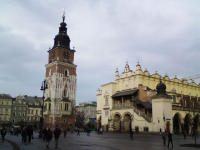
About
Cracow (Polish Kraków [Kra:kuff], is the second largest city in Poland with a population of over 800,000 inhabitants. It is one of the most important cultural, economic and academic sites of Poland. In the course of over thousand years of history, it has been an active intellectual hub and important religious and political centre. In the first centuries of Polish statehood Krakow was the capital city, the seat of the kings of the Piast dynasty and the Jagiellonian dynasty. The last of the Piasts, Casimir the Great, founded in 1364 the Cracow Academy. The Academy declined after the death of its founder but shortly after in 1400 it was revived by King Ladislaus Jagiello and developed in the 15th century into a university with a high standard of learning.
In the epoch of Renaissance Krakow as a capital of Poland was modernized and enlarged. With the end of the Jagiellonian dynasty and the era of elected kings Krakow's role diminished, especially when one of the elected rulers, Swedish king Gustavus Vasa, moved the capital from Krakow to Warsaw, a site located much closer to his homeland.
Following the partition of Poland (1795-1918) Krakow belonged to the Austrian empire. In the last decades of the 19th century, due to political reforms introduced by the Habsburgs, Krakow enjoyed a relative autonomy and turned into an important intellectual, scientific and cultural centre of the Austro-Hungarian empire.
After Poland regained its independence in 1918, Krakow continued to be a strong intellectual and scientific centre, and the Jagiellonian University became a renown academic institution, particularly strong in the fields of law, history, philosophy, mathematics, biology, linguistics.
The outbreak of the World War II had dramatic consequences for the city and its largest university. Although Krakow was not as much destroyed as Warsaw, the population suffered greatly from the German occupation. Krakow's Jews, who had been settled in the quarter of Kazimierz since the end of the 14th century, fell victims of the Nazi invasion. They were forcibly herded into a ghetto, the site of horrendous atrocities, and the majority were transported to Auschwitz.
The Jagiellonian University was closed by the German occupiers who in November 1939 made a bloody pacification arresting 183 university professors and lecturers and putting them in a concentration camp in Sachsenhausen where many of them lost their lives. Starting in 1942, the Jagiellonian University began to teach clandestinely.
Following the end of war, Krakow strongly opposed the growing Communist influence. After consolidating their power the ruling Communist party decided to build a giant steel plant to give an industrial boost to the region but also to counterbalance the "Conservative" Krakow by the "Proletarian" class working in the Lenin steelworks. Nowadays the steelworks and the adjacent district Howa Huta are one of tourist attractions.
We recommend the following sources of information and knowledge about Krakow's history:
Malopolska Province (Voivodship)
Malopolska is one of Poland’s 16 administrative provinces (voivodships), with Krakow as the capital city, and comprises 8.3 percent of the country’s population. It has its own provincial council and the executive, albeit both with limited powers.
The Malopolska province makes up the chief part of Poland’s larger historical region of Malopolska bordering on the Ukraine to the east and Slovakia to the south, and on the Polish regions of Silesia to the west and Mazowsze to the north. It is an area of charming beauty, with copious medieval towns and castles dotting the hillsides and the Tatra Mountains covered with lush vegetation. A perfect place for those fond of diverse scenery with great walks, hikes, skiing, biking, fishing, camping out in the open, etc.
More info:
http://www.krakow-info.com/malopol.htm
http://welcometo.pl/informations/
http://mcit-tours.co.uk/
Communication
The city of Cracow is located in the south of Poland, at the crossing of important transportation routes. Getting there as well as around is pretty easy. The city has a fairly dense public transport system which consists of tramways and bus lines that mostly a municipal company operates and a number of private-owned minibus fleets. Some suburban areas are connected by local commuter trains. See more: local info
Additional information
We strongly recommend visiting a web page
„Magiczny Kraków" (Magic Cracow) in English, as well as other languages, for an up-to-date and substantial information on what's up in the town
Info for tourists, interesting events, museums & galleries:
Kraków travel
Practical information on accommodation, food & drinks:
Cracow Life


